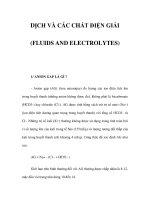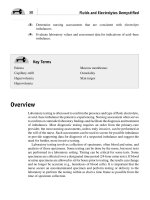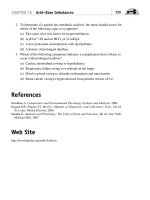Ebook Fluids and electrolytes made incredibly easy (6/E): Part 1
Bạn đang xem bản rút gọn của tài liệu. Xem và tải ngay bản đầy đủ của tài liệu tại đây (3.7 MB, 251 trang )
made
Fluids &Electrolytes
Sixth Edition
0 .Wolters Kluwer
Phb6clph!a • 8albm0~ • New Yotk • london
Buenos A11H • Hong Kong • sydney • Tol
AcquisitionsEditor:ShannonW.Magee
ProductDevelopmentEditor:MariaM.McAvey
SeniorMarketingManager:MarkWiragh
EditorialAssistant:ZacharyShapiro
ProductionProjectManager:MarianBellus
DesignCoordinator:ElaineKasmer
ManufacturingCoordinator:KathleenBrown
PrepressVendor:AbsoluteService,Inc.
SixthEdition
Copyright©2015WoltersKluwerHealth
Copyright©2010LippincottWilliams&Wilkins
Allrightsreserved.Thisbookisprotectedbycopyright.Nopartofthisbookmaybereproducedortransmittedinanyformorbyanymeans,
includingasphotocopiesorscanned-inorotherelectroniccopies,orutilizedbyanyinformationstorageandretrievalsystemwithoutwritten
permissionfromthecopyrightowner,exceptforbriefquotationsembodiedincriticalarticlesandreviews.Materialsappearinginthisbook
preparedbyindividualsaspartoftheirofficialdutiesasU.S.governmentemployeesarenotcoveredbytheabove-mentionedcopyright.To
requestpermission,pleasecontactWoltersKluwerHealthatTwoCommerceSquare,2001MarketStreet,Philadelphia,PA19103,viaemailat
,orviaourwebsiteatlww.com(productsandservices).
PrintedinChina
LibraryofCongressCataloging-in-PublicationData
Fluids&electrolytesmadeincrediblyeasy!/clinicaleditor,LauraWillis.—Sixthedition.
p.;cm.
Fluidsandelectrolytesmadeincrediblyeasy!
Includesbibliographicalreferencesandindex.
ISBN978-1-4511-9396-1
I.Willis,Laura,1969-editor.II.LippincottWilliams&Wilkins,issuingbody.III.Title:Fluidsandelectrolytesmadeincrediblyeasy!
[DNLM:1.Water-ElectrolyteImbalance—Nurses’Instruction.2.Water-ElectrolyteBalance—Nurses’Instruction.WD220]
RC630
616.3’9920231—dc23
2014043245
Thisworkisprovided“asis,”andthepublisherdisclaimsanyandallwarranties,expressorimplied,includinganywarrantiesastoaccuracy,
comprehensiveness,orcurrencyofthecontentofthiswork.
Thisworkisnosubstituteforindividualpatientassessmentbasedonhealthcareprofessionals’examinationofeachpatientand
considerationof,amongotherthings,age,weight,gender,currentorpriormedicalconditions,medicationhistory,laboratorydata,andother
factorsuniquetothepatient.Thepublisherdoesnotprovidemedicaladviceorguidanceandthisworkismerelyareferencetool.Healthcare
professionals,andnotthepublisher,aresolelyresponsiblefortheuseofthisworkincludingallmedicaljudgmentsandforanyresulting
diagnosisandtreatments.
Givencontinuous,rapidadvancesinmedicalscienceandhealthinformation,independentprofessionalverificationofmedicaldiagnoses,
indications,appropriatepharmaceuticalselectionsanddosages,andtreatmentoptionsshouldbemadeandhealthcareprofessionalsshould
consultavarietyofsources.Whenprescribingmedication,healthcareprofessionalsareadvisedtoconsulttheproductinformationsheet(the
manufacturer’spackageinsert)accompanyingeachdrugtoverify,amongotherthings,conditionsofuse,warnings,andsideeffectsand
identifyanychangesindosagescheduleorcontradictions,particularlyifthemedicationtobeadministeredisnew,infrequentlyused,orhasa
narrowtherapeuticrange.Tothemaximumextentpermittedunderapplicablelaw,noresponsibilityisassumedbythepublisherforanyinjury
and/ordamagetopersonsorproperty,asamatterofproductsliability,negligencelaworotherwise,orfromanyreferencetoorusebyany
personofthiswork.
LWW.com
987654321
Contents
PartI
Contributors
Priorcontributors
Foreword
Balancingbasics
1
Balancingfluids
2
Balancingelectrolytes
3
Balancingacidsandbases
PartII
Fluidandelectrolyteimbalances
4
Whenfluidstipthebalance
5
Whensodiumtipsthebalance
6
Whenpotassiumtipsthebalance
7
Whenmagnesiumtipsthebalance
8
Whencalciumtipsthebalance
9
Whenphosphorustipsthebalance
10
Whenchloridetipsthebalance
11
Whenacidsandbasestipthebalance
PartIII
Disordersthatcauseimbalances
12
Heat-relatedhealthalterations
13
Heartfailure
14
Respiratoryfailure
15
ExcessiveGIfluidloss
16
Acutepancreatitis
17
Renalfailure
18
Burns
PartIV
Treatingimbalances
19
I.V.fluidreplacement
20
Totalparenteralnutrition
Appendicesandindex
Commonfluidandelectrolyteimbalancesinpediatricpatients
Commonfluidandelectrolyteimbalancesinelderlypatients
Transfusingbloodandselectedcomponents
Practicemakesperfect
Glossary
SelectedReferences
Index
Contributors
CherylBrady,MSN,RN,CNE
NursingFaculty
KentStateUniversity
Salem,OH
ShelbaDurston,MSN,RN,CCRN
NursingInstructor
SanJoaquinDeltaCollege
Stockton,CA
LauraFavand,MS,RN,CEN
ChiefofPlans,TrainingMobilization
U.S.ArmyMedicalDepartmentActivities
FortKnox,KY
MargaretGingrich,MSN,RN,CRNP
ProfessorofNursing
HarrisburgAreaCommunityCollege
Harrisburg,PA
MaryJones,DNP,CNM,ENP-BC,FNP-BC
FamilyNursePractitioner
DoctorofNursingPractice
MedQuestHealthCenter,Inc.
Mansfield,OH
RexannPickering,PhD,MS,RN,CIM,CIP
DirectorofContinuingMedicalandNursingEducation
MethodistLeBonheurHealthcare
Memphis,TN
CherieRebar,PhD,MBA,RN,FNP,COI
Director,DivisionofNursing
KetteringCollege
Dayton,OH
DonnaScemons,PhD,FNP-BC,CNS
AssistantProfessor
CaliforniaStateUniversity
LosAngeles,CA
AllisonTerry,PhD,MSN,RN
AssistantDeanofClinicalPractice
AuburnUniversity
Montgomery,AL
LeighAnnTrujillo,MSN,RN
PatientCareManager
UniversityofChicago
Chicago,IL
PriorContributors
CherylL.Brady,MSN,RN
ShelbaDurston,MSN,RN,CCRN
LauraR.Favand,MS,RN,CEN
MargaretM.Gingrich,MSN,RN
KarlaJones,MS,RN
PatriciaLemelle-Wright,MS,RN
LindaLudwig,BS,RN,MED
RexannG.Pickering,PhD,MS,RN,CIP,CIM
AlexisPuglia,RN
RoseanneHanlonRafter,MSN,RN,GCNS-BC
DonnaScemons,PhD,RN,FNP-C,CNS
VanessaM.Scheidt,RN,TNS,PHRN,FF2
AllisonJ.Terry,PhD,MSN,RN
LeighAnnTrujillo,BSN,RN
Foreword
Ifyouarelikeme,youaretoobusytowadethroughaforewordthatusespretentioustermsand
umpsteendullparagraphstogettothepoint.Solet’scutrighttothechase!Hereiswhythisbookis
soterrific:
1.Itwillteachyoualltheimportantthingsyouneedtoknowaboutfluidsandelectrolytes.(Itwill
leaveoutallthefluffthatwastesyourtime.)
2.Itwillhelpyourememberwhatyouhavelearned.
3.Itwillmakeyousmileasitenhancesyourknowledgeandskills.Don’tbelieveme?Trythese
recurringlogosonforsize:
Memoryjogger!—helpsyourememberandunderstanddifficultconcepts
CAUTION!—listsdangeroussignsandsymptomsandenablesyoutoquicklyrecognize
trouble
It’snotworking—helpsyoufindalternativeinterventionswhenpatientoutcomesaren’twhat
youexpected
Chartsmart—listscriticaldocumentationelementsthatcankeepyououtoflegaltrouble
Teachingpoints—providesclearpatient-teachingtipsthatyoucanusetohelpyourpatients
preventrecurrenceoftheproblem
Agesandstages—identifiesissuestowatchforinyourpediatricandgeriatricpatients
That’sawrap!—summarizeswhatyou’velearnedinthechapter
See?Itoldyou!Andthat’snotall.Lookformeandmyfriendsinthemarginsthroughoutthisbook.
Wewillbetheretoexplainkeyconcepts,provideimportantcarereminders,andofferreassurance.
Oh,andifyoudon’tmind,we’llbespicingupthepageswithabitofhumoralongthewaytoteach
andentertaininawaythatnootherresourcecan.
Ihopeyoufindthisbookhelpful.Bestofluckthroughoutyourcareer!
PartI
Balancingbasics
1
Balancing
fluids
2
Balancing
electrolytes
3
Balancing
acidsand
bases
Chapter1
Balancingfluids
Justthefacts
Inthischapter,you’lllearn:
♦
theprocessoffluiddistributionthroughoutthebody
♦
themeaningsofcertainfluid-relatedterms
♦
thedifferentwaysfluidmovesthroughthebody
♦
therolesthathormonesandkidneysplayinfluidbalance.
Alookatfluids
Wherewouldwebewithoutbodyfluids?Fluidsarevitaltoallformsoflife.Theyhelpmaintain
bodytemperatureandcellshape,andtheyhelptransportnutrients,gases,andwastes.Let’stakea
closelookatfluidsandthewaythebodybalancesthem.
Makinggainsequallosses
Justaboutallmajororgansworktogethertomaintaintheproperbalanceoffluid.Tomaintainthat
balance,theamountoffluidgainedthroughoutthedaymustequaltheamountlost.Someofthose
lossescanbemeasured;otherscan’t.
Howinsensible
Fluidlossesfromtheskinandlungsarereferredtoasinsensiblelossesbecausetheycan’tbe
measuredorseen.Lossesfromevaporationoffluidthroughtheskinarefairlyconstantbutdepend
onaperson’stotalbodysurfacearea.Forexample,thebodysurfaceareaofaninfantisgreater
thanthatofanadultrelativetotheirrespectiveweights.Becauseofthisdifferenceinbodysurface
area—ahighermetabolicrate,alargerpercentageofextracellularbodyfluid,andimmature
kidneyfunction—infantstypicallylosemorewaterthanadultsdo.
Changesinenvironmentalhumiditylevelsalsoaffecttheamountoffluidlostthroughtheskin.
Likewise,respiratoryrateanddepthaffecttheamountoffluidlostthroughthelungs.Tachypnea,
forexample,causesmorewatertobelost;bradypnea,less.Feverincreasesinsensiblelossesof
fluidfromboththeskinandlungs.
Nowthat’ssensible
Fluidlossesfromurination,defecation,wounds,andothermeansarereferredtoassensible
lossesbecausetheycanbemeasured.
Atypicaladultlosesabout150to200ml/dayoffluidthroughdefecation.Incasesofsevere
diarrhea,lossesmayexceed5,000ml/day(Wait&Alouidor,2011).(Formoreinformationabout
insensibleandsensiblelosses,seeSitesinvolvedinfluidloss.)
Sitesinvolvedinfluidloss
Eachday,thebodygainsandlosesfluidthroughseveraldifferentprocesses.Thisillustrationshows
theprimarysitesoffluidlossesandgainsaswellastheiraverageamounts.Gastric,intestinal,
pancreatic,andbiliarysecretionsarealmostcompletelyreabsorbedandaren’tusuallycountedin
dailyfluidlossesandgains.
Followingthefluid
Thebodyholdsfluidintwobasicareas,orcompartments—insidethecellsandoutsidethecells.
Fluidfoundinsidethecellsiscalledintracellularfluid(ICF);fluidfoundoutsidethecells,
extracellularfluid(ECF).Capillarywallsandcellmembranesseparatetheintracellularand
extracellularcompartments.(SeeFluidcompartments.)
Fluidcompartments
Thisillustrationshowstheprimaryfluidcompartmentsinthebody:intracellularandextracellular.
Extracellularisfurtherdividedintointerstitialandintravascular.Capillarywallsandcellmembranes
separateICFsfromECFs.
Memoryjogger
Tohelpyourememberwhichfluidbelongsinwhichcompartment,keepinmindthatintermeans
between(asininterval—betweentwoevents)andintrameanswithinorinside(asinintravenous
—insideavein).
Tomaintainproperfluidbalance,thedistributionoffluidbetweenthetwocompartmentsmust
remainrelativelyconstant.Inanaverageadult,thetotalamountoffluidis42L,withthetotal
amountofICFaveraging40%oftheperson’sbodyweight,orabout28L(Seager&Slaubaugh,
2011).ThetotalamountofECFaverages20%oftheperson’sbodyweight,orabout14L.
ECFcanbebrokendownfurtherintointerstitialfluid,whichsurroundsthecells,and
intravascularfluidorplasma,whichistheliquidportionofblood.Inanadult,interstitialfluid
accountsforabout75%oftheECF.Plasmaaccountsfortheremaining25%.
Thebodycontainsotherfluids,calledtranscellularfluids,inthecerebrospinalcolumn,pleural
cavity,lymphsystem,joints,andeyes.Transcellularfluidsgenerallyaren’tsubjecttosignificant
gainsandlossesthroughoutthedaysotheyaren’tdiscussedindetailhere.
Waterhere,waterthere
Thedistributionoffluidwithinthebody’scompartmentsvarieswithage.Comparedwithadults,
infantshaveagreaterpercentageofbodywaterstoredinsideinterstitialspaces.About75%to
80%(40%ECF,35%ICF)ofthebodyweightofafull-termneonateiswater.About90%(60%
ECFand30%ICF)ofthebodyweightofapremature(23weeksgestation)infantiswater
(Ambalavanan&Rosenkrantz,2012).Theamountofwaterasapercentageofbodyweight
decreaseswithageuntilpuberty.Inatypical154-lb(70kg)leanadultmale,about60%(93lb[42
kg])ofbodyweightiswater.(SeeTheevaporationoftime.)
Agesandstages
Theevaporationoftime
Theriskofsufferingafluidimbalanceincreaseswithage.Why?Skeletalmusclemassdeclines,and
theproportionoffatwithinthebodyincreases.Afterage60years,watercontentdropstoabout45%.
Likewise,thedistributionoffluidwithinthebodychangeswithage.Forinstance,about15%ofa
typicalyoungadult’stotalbodyweightismadeupofinterstitialfluid.Thatpercentageprogressively
decreaseswithage.
About5%ofthebody’stotalfluidvolumeismadeupofplasma.Plasmavolumeremainsstable
throughoutlife.
Skeletalmusclecellsholdmuchofthatwater;fatcellscontainlittleofit.Women,who
normallyhaveahigherratiooffattoskeletalmusclethanmen,typicallyhaveasomewhatlower
relativewatercontent.Likewise,anobesepersonmayhavearelativewatercontentlevelaslow
as45%.Accumulatedbodyfatintheseindividualsincreasesweightwithoutboostingthebody’s
watercontent.
Fluidtypes
Fluidsinthebodygenerallyaren’tfoundinpureforms.They’reusuallyfoundinthreetypesof
solutions:isotonic,hypotonic,andhypertonic.
Isotonic:Alreadyatmatchpoint
Anisotonicsolutionhasthesamesolute(matterdissolvedinsolution)concentrationasanother
solution.Forinstance,iftwofluidsinadjacentcompartmentsareequallyconcentrated,they’re
alreadyinbalance,sothefluidinsideeachcompartmentstaysput.Noimbalancemeansnonet
fluidshift.(SeeUnderstandingisotonicfluids.)
Understandingisotonicfluids
Nonetfluidshiftsoccurbetweenisotonicsolutionsbecausethesolutionsareequallyconcentrated.
Forexample,normalsalinesolutionisconsideredisotonicbecausetheconcentrationofsodium
inthesolutionnearlyequalstheconcentrationofsodiumintheblood.
Hypotonic:Getthelowdown
Ahypotonicsolutionhasalowersoluteconcentrationthananothersolution.Forinstance,sayone
solutioncontainsonlyonepartsodiumandanothersolutioncontainstwoparts.Thefirstsolution
ishypotoniccomparedwiththesecondsolution.Asaresult,fluidfromthehypotonicsolution
wouldshiftintothesecondsolutionuntilthetwosolutionshadequalconcentrationsofsodium.
Rememberthatthebodyconstantlystrivestomaintainastateofbalance,orequilibrium(also
knownashomeostasis).(SeeUnderstandinghypotonicfluids.)
Understandinghypotonicfluids
Whenalessconcentrated,orhypotonic,solutionisplacednexttoamoreconcentratedsolution,fluid
shiftsfromthehypotonicsolutionintothemoreconcentratedcompartmenttoequalizeconcentrations.
Half-normalsalinesolutionisconsideredhypotonicbecausetheconcentrationofsodiuminthe
solutionislessthantheconcentrationofsodiuminthepatient’sblood.
Hypertonic:Justthehighlights
Ahypertonicsolutionhasahighersoluteconcentrationthananothersolution.Forinstance,sayone
solutioncontainsalargeamountofsodiumandasecondsolutioncontainshardlyany.Thefirst
solutionishypertoniccomparedwiththesecondsolution.Asaresult,fluidfromthesecond
solutionwouldshiftintothehypertonicsolutionuntilthetwosolutionshadequalconcentrations.
Again,thebodyconstantlystrivestomaintainastateofequilibrium(homeostasis).(See
Understandinghypertonicfluids.)
Understandinghypertonicfluids
Ifonesolutionhasmoresolutesthananadjacentsolution,ithaslessfluidrelativetotheadjacent
solution.Fluidwillmoveoutofthelessconcentratedsolutionintothemoreconcentrated,or
hypertonic,solutionuntilbothsolutionshavethesameamountofsolutesandfluid.
Forexample,asolutionofdextrose5%innormalsalinesolutionisconsideredhypertonic
becausetheconcentrationofsolutesinthesolutionisgreaterthantheconcentrationofsolutesin
thepatient’sblood.
Fluidmovement
Justastheheartconstantlybeats,fluidsandsolutesconstantlymovewithinthebody.That
movementallowsthebodytomaintainhomeostasis,theconstantstateofbalancethebodyseeks.
(SeeFluidtips.)
Fluidtips
Fluids,nutrients,andwasteproductsconstantlyshiftwithinthebody’scompartments—fromthecells
totheinterstitialspaces,tothebloodvessels,andbackagain.Achangeinonecompartmentcanaffect
alloftheothers.
Keepingtrackoftheshifts
Thatcontinuousshiftingoffluidscanhaveimportantimplicationsforpatientcare.Forinstance,ifa
hypotonicfluid,suchashalf-normalsalinesolution,isgiventoapatient,itmaycausetoomuchfluid
tomovefromtheveinsintothecells,andthecellscanswell.Ontheotherhand,ifahypertonic
solution,suchasdextrose5%innormalsalinesolution,isgiventoapatient,itmaycausetoomuch
fluidtobepulledfromcellsintothebloodstream,andthecellsshrink.
FormoreinformationaboutI.V.solutions,seechapter19,I.V.fluidreplacement.
Withinthecells
Soluteswithintheintracellular,interstitial,andintravascularcompartmentsofthebodymove
throughthemembranes,separatingthosecompartmentsindifferentways.Themembranesare
semipermeable,meaningthattheyallowsomesolutestopassthroughbutnotothers.Inthis
section,you’lllearnthedifferentwaysfluidsandsolutesmovethroughmembranesatthecellular
level.
Goingwiththeflow
Indiffusion,solutesmovefromanareaofhigherconcentrationtoanareaoflowerconcentration,
whicheventuallyresultsinanequaldistributionofsoluteswithinthetwoareas.Diffusionisa
formofpassivetransportbecausenoenergyisrequiredtomakeithappen;itjusthappens.Like
fishswimmingwiththecurrent,thesolutessimplygowiththeflow.(SeeUnderstanding
diffusion.)
Understandingdiffusion
Indiffusion,solutesmovefromareasofhigherconcentrationtoareasoflowerconcentrationuntilthe
concentrationisequalinbothareas.
Givingthatextrapush
Inactivetransport,solutesmovefromanareaoflowerconcentrationtoanareaofhigher
concentration.Likeswimmingagainstthecurrent,activetransportrequiresenergytomakeit
happen.
Theenergyrequiredforasolutetomoveagainstaconcentrationgradientcomesfroma
substancecalledadenosinetriphosphateorATP.Storedinallcells,ATPsuppliesenergyfor
solutemovementinandoutofcells.(SeeUnderstandingactivetransport.)
Understandingactivetransport
Duringactivetransport,energyfromamoleculecalledadenosinetriphosphate(ATP)movessolutes
fromanareaoflowerconcentrationtoanareaofhigherconcentration.
Somesolutes,suchassodiumandpotassium,useATPtomoveinandoutofcellsinaformof
activetransportcalledthesodium-potassiumpump.(Formoreinformationonthisphysiologic
pump,seechapter5,Whensodiumtipsthebalance.)Othersolutesthatrequireactivetransportto
crosscellmembranesincludecalciumions,hydrogenions,aminoacids,andcertainsugars.
Lettingfluidsthrough
Osmosisreferstothepassivemovementoffluidacrossamembranefromanareaoflowersolute
concentrationandcomparativelymorefluidintoanareaofhighersoluteconcentrationand
comparativelylessfluid.Osmosisstopswhenenoughfluidhasmovedthroughthemembraneto
equalizethesoluteconcentrationonbothsidesofthemembrane.(SeeUnderstandingosmosis.)
Understandingosmosis
Inosmosis,fluidmovespassivelyfromareaswithmorefluid(andfewersolutes)toareaswithless
fluid(andmoresolutes).Rememberthatinosmosis,fluidmoves,whereasindiffusion,solutesmove.
Withinthevascularsystem
Withinthevascularsystem,onlycapillarieshavewallsthinenoughtoletsolutespassthrough.
Themovementoffluidsandsolutesthroughcapillarywallsplaysacriticalroleinthebody’sfluid
balance.
Thepressureison
Themovementoffluidsthroughcapillaries—aprocesscalledcapillaryfiltration—resultsfrom
bloodpushingagainstthewallsofthecapillary.Thatpressure,calledhydrostaticpressure,forces
fluidsandsolutesthroughthecapillarywall.
Whenthehydrostaticpressureinsideacapillaryisgreaterthanthepressureinthesurrounding
interstitialspace,fluidsandsolutesinsidethecapillaryareforcedoutintotheinterstitialspace.
Whenthepressureinsidethecapillaryislessthanthepressureoutsideofit,fluidsandsolutes
movebackintothecapillary.(SeeFluidmovementthroughcapillaries.)
Fluidmovementthroughcapillaries
Whenhydrostaticpressurebuildsinsideacapillary,itforcesfluidsandsolutesoutthroughthe
capillarywallsintotheinterstitialfluid,asshownbelow.
Keepingthefluidin
Aprocesscalledreabsorptionpreventstoomuchfluidfromleavingthecapillariesnomatterhow
muchhydrostaticpressureexistswithinthecapillaries.Whenfluidfiltersthroughacapillary,the
proteinalbuminremainsbehindinthediminishingvolumeofwater.Albuminisalargemolecule
thatnormallycan’tpassthroughcapillarymembranes.Astheconcentrationofalbumininsidea
capillaryincreases,fluidbeginstomovebackintothecapillariesthroughosmosis.
Thinkofalbuminasawatermagnet.Theosmotic,orpulling,forceofalbumininthe
intravascularspaceiscalledtheplasmacolloidosmoticpressure.Theplasmacolloidosmotic
pressureincapillariesaveragesabout25mmHg.(SeeAlbuminmagnetism.)
Albuminmagnetism
Albumin,alargeproteinmolecule,actslikeamagnettoattractwaterandholditinsidetheblood
vessel.
Aslongascapillarybloodpressure(thehydrostaticpressure)exceedsplasmacolloidosmotic
pressure,waterandsolutescanleavethecapillariesandentertheinterstitialfluid.When
capillarybloodpressurefallsbelowplasmacolloidosmoticpressure,wateranddiffusible
solutesreturntothecapillaries.
Normally,bloodpressureinacapillaryexceedsplasmacolloidosmoticpressureinthe
arterioleendandfallsbelowitinthevenuleend.Asaresult,capillaryfiltrationoccursalongthe
firsthalfofthevessel;reabsorption,alongthesecond.Aslongascapillarybloodpressureand
plasmaalbuminlevelsremainnormal,theamountofwaterthatmovesintothevesselequalsthe
amountthatmovesout.
Comingaroundagain
Occasionally,extrafluidfiltersoutofthecapillary.Whenthathappens,theexcessfluidshiftsinto
thelymphaticvesselslocatedjustoutsidethecapillariesandeventuallyreturnstotheheartfor
recirculation.
Maintainingthebalance
Manymechanismsinthebodyworktogethertomaintainfluidbalance.Becauseoneproblemcan
affecttheentirefluid-maintenancesystem,it’simportanttokeepallmechanismsincheck.Here’sa
closerlookatwhatmakesthisbalancingactpossible.









